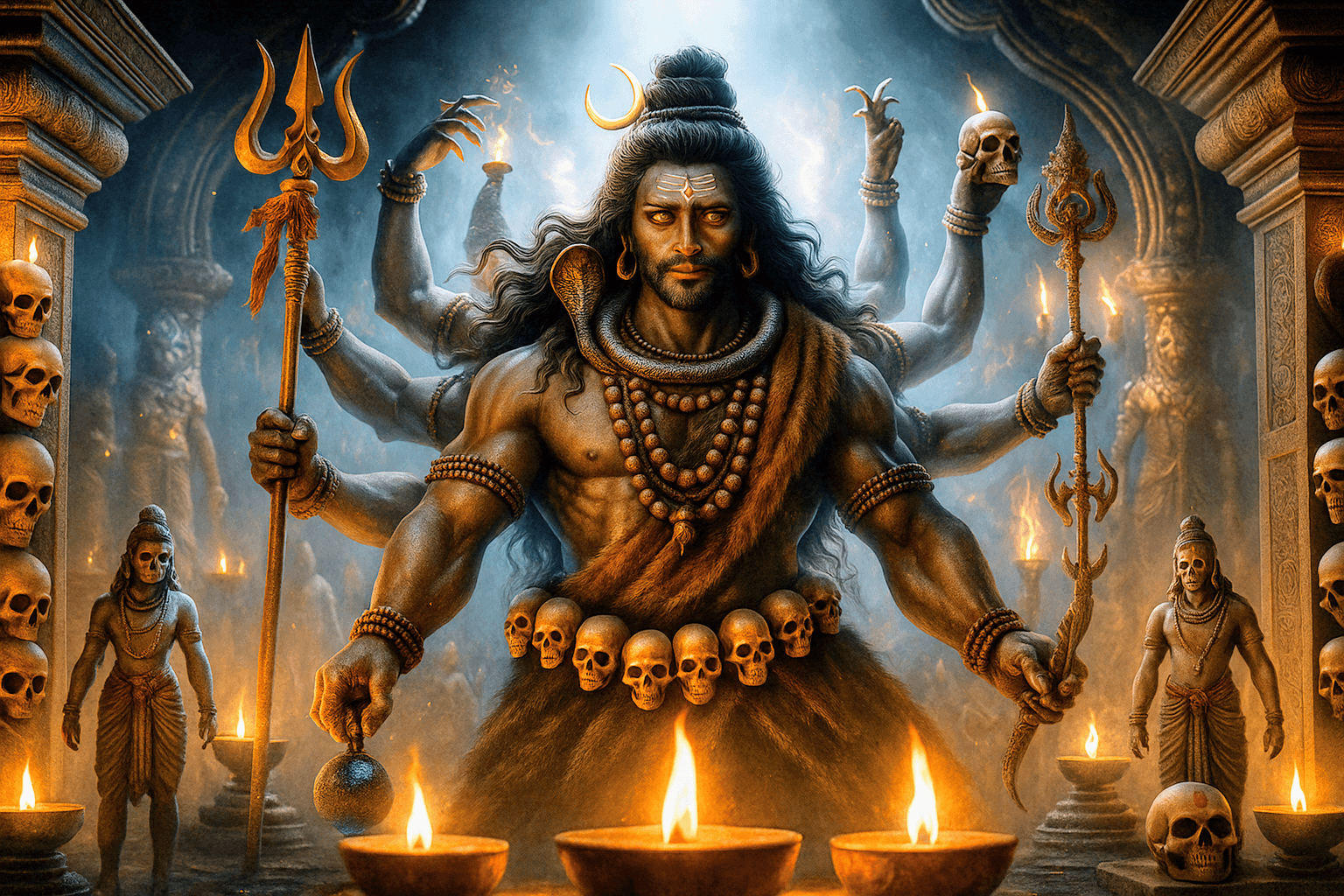Introduction
In the vast spiritual traditions of Hinduism, Lord Bhairava holds a unique and powerful position as a fierce manifestation of Lord Shiva. He is the embodiment of supreme knowledge, time, and transformation. One of the esoteric teachings associated with Bhairava is Ashtanga Bhairava, which translates to the “Eightfold Bhairava.” This doctrine is deeply rooted in the Shaivite and Tantric traditions, guiding practitioners toward self-realization through eight distinct aspects of Bhairava’s wisdom.
The Ashtanga Bhairava teachings are believed to be imparted by Lord Shiva to Goddess Parvati, detailing various meditation techniques, mantras, and spiritual disciplines that enable devotees to attain enlightenment. In this article, we will explore the meaning, significance, and aspects of Ashtanga Bhairava in depth.
Who is Bhairava?
Bhairava is one of the most fearsome and revered manifestations of Lord Shiva. He is often depicted with a fierce expression, holding weapons, and adorned with skulls, symbolizing the destruction of ignorance and the transcendence of worldly attachments. Bhairava represents time (Kala), the ultimate force that governs birth and death, and is worshipped across various Shaivite sects, particularly in the Kapalika and Aghori traditions.
Bhairava is also considered the guardian of the eight directions (Ashta Dikpalakas), ensuring cosmic balance. His worship is prevalent in Tantra, where he is seen as the gateway to mystical experiences and deeper understanding of the universe.
The Concept of Ashtanga Bhairava
The term Ashtanga Bhairava refers to the eightfold path of Bhairava’s wisdom. Each of these eight aspects embodies a particular philosophical or yogic discipline that guides practitioners toward spiritual awakening. The Ashtanga Bhairava path can be considered analogous to the Ashtanga Yoga of Patanjali, though it is more deeply embedded in the Shaiva and Tantra traditions.
The eight aspects of Ashtanga Bhairava are:
- Kala Bhairava – The Lord of Time and Transformation
- Asitanga Bhairava – The Formless and Infinite Bhairava
- Ruru Bhairava – The Compassionate Guru and Guide
- Chanda Bhairava – The Fierce Destroyer of Evil
- Krodha Bhairava – The Embodiment of Righteous Anger
- Unmatta Bhairava – The Ecstatic and Unconventional One
- Kapala Bhairava – The Bearer of the Skull and Symbol of Detachment
- Bheeshana Bhairava – The Terrifying and Fearsome Protector
Each of these aspects represents a unique dimension of Bhairava’s teachings, assisting spiritual seekers in overcoming obstacles and realizing their highest potential.
1. Kala Bhairava – The Lord of Time and Transformation
Kala Bhairava is the master of time, reminding devotees of the impermanence of life and the need for spiritual discipline. Worshiping Kala Bhairava is believed to protect individuals from negative influences, untimely death, and obstacles in life. His teachings emphasize mindfulness, meditation on the transient nature of existence, and the necessity of living in the present moment.
2. Asitanga Bhairava – The Formless and Infinite Bhairava
Asitanga Bhairava represents the infinite and formless nature of Shiva. He signifies the dissolution of the ego and the realization that the self is beyond physical existence. This aspect of Bhairava is deeply connected with meditative practices aimed at attaining a state of pure consciousness and non-duality.
3. Ruru Bhairava – The Compassionate Guru and Guide
Ruru Bhairava is depicted as the benevolent teacher who guides his devotees with wisdom and compassion. He represents knowledge, discipline, and learning. Practicing devotion to Ruru Bhairava helps individuals attain clarity of thought, ethical behavior, and a deeper understanding of spiritual truths.
4. Chanda Bhairava – The Fierce Destroyer of Evil
Chanda Bhairava embodies the relentless force that destroys negativity, ignorance, and darkness. He represents divine justice and the cosmic law that ensures righteousness prevails. His teachings encourage individuals to cultivate inner strength and decisiveness in the face of adversity.
5. Krodha Bhairava – The Embodiment of Righteous Anger
Krodha Bhairava symbolizes controlled anger that is used for the greater good. Unlike uncontrolled rage, which leads to destruction, Krodha Bhairava teaches the importance of channeling anger constructively to fight injustice and protect Dharma (righteousness).
6. Unmatta Bhairava – The Ecstatic and Unconventional One
Unmatta Bhairava represents divine madness and spiritual ecstasy. He symbolizes transcendence beyond conventional norms and societal conditioning. This aspect encourages seekers to break free from limiting beliefs and experience unbounded joy through devotion and surrender.
7. Kapala Bhairava – The Bearer of the Skull and Symbol of Detachment
Kapala Bhairava is often depicted carrying a skull, symbolizing the detachment from material desires and the realization of the transient nature of the body. His teachings emphasize renunciation, asceticism, and inner contemplation.
8. Bheeshana Bhairava – The Terrifying and Fearsome Protector
Bheeshana Bhairava represents the ultimate protector of devotees. He instills fear in negative forces and safeguards spiritual seekers from harm. His presence in one’s life signifies courage, resilience, and unwavering faith in divine protection.
The Significance of Ashtanga Bhairava in Spiritual Practice
The Ashtanga Bhairava path is not merely a theoretical concept but a practical guide to spiritual transformation. By meditating upon and invoking these eight forms of Bhairava, practitioners can:
- Develop fearlessness and inner strength
- Cultivate discipline and detachment from worldly illusions
- Attain higher states of consciousness through meditation
- Overcome negativity and obstacles in life
- Deepen their connection with the divine
Tantric and Shaivite traditions often include rituals, mantras, and meditation techniques dedicated to the worship of Bhairava. One of the most revered practices is the chanting of the Kala Bhairava Ashtakam, a hymn dedicated to Lord Kala Bhairava, which is believed to bestow protection, wisdom, and liberation upon the devotee.
Conclusion
Ashtanga Bhairava is a profound spiritual doctrine that offers a structured yet deeply mystical path to enlightenment. Each of the eight Bhairavas represents a crucial aspect of divine wisdom, guiding seekers through the trials of life toward ultimate self-realization. Whether approached through devotion, meditation, or yogic discipline, the teachings of Ashtanga Bhairava remain a timeless source of inspiration for those on the spiritual path.
By embracing the wisdom of these eight forms, one can transcend limitations, embrace inner transformation, and realize the boundless potential of the self. In a world filled with uncertainty, the path of Ashtanga Bhairava provides a powerful means to attain inner peace, resilience, and spiritual awakening.
(FAQ’s)
1. What is the significance of Ashtanga Bhairava?
Ashtanga Bhairava represents the eightfold wisdom of Bhairava, guiding devotees toward spiritual awakening, inner strength, and divine realization.
2. How can one worship Ashtanga Bhairava?
Worship can be done through meditation, chanting Bhairava mantras, performing rituals, and following the teachings of Bhairava in daily life.
3. Is Bhairava worship limited to Shaivism?
While Bhairava is a manifestation of Shiva, his worship extends to Tantra, Shakta traditions, and even some Buddhist practices like Vajrayana.
4. What benefits does worshiping Bhairava bring?
Devotees seek protection, wisdom, spiritual progress, fearlessness, and removal of obstacles through Bhairava worship.
5. Are there temples dedicated to Ashtanga Bhairava?
Yes, several temples in India, such as the Kala Bhairava Temple in Ujjain, are dedicated to Bhairava, with specific shrines for different forms.


Interesting! Can you explain more about the significance of Ashtanga Bhairava in Hindu spirituality?
Bhagavan Bhairava aur Lord Shiva ke baare mein yeh jankari bahut prernaadayak hai. Unki kathayen hamare jeevan mein dhairya aur shakti ka sandesh deti hain. Ashtanga Bhairava ki shiksha hamen gyan aur parivartan ki mahima samajhne mein madad karti hai. Lord Ganesha aur Kannappa ki kahaaniyan bhakti aur samarpit bhav ki shiksha deti hain. Kya aap in kathaon ke madhyam se apne jeevan mein koi anokha anubhav paye hain?
Every line seems to carry a deeper meaning, as if the words are part of a larger conversation about life itself.